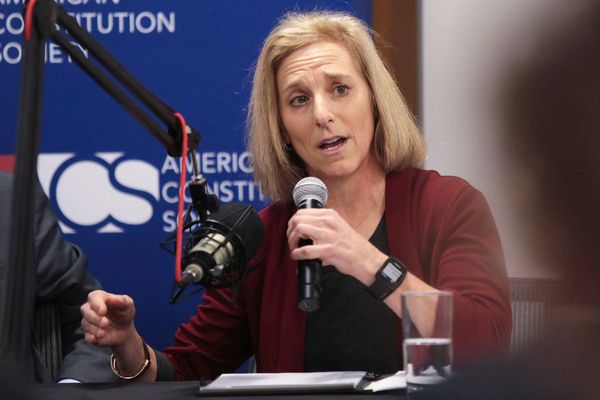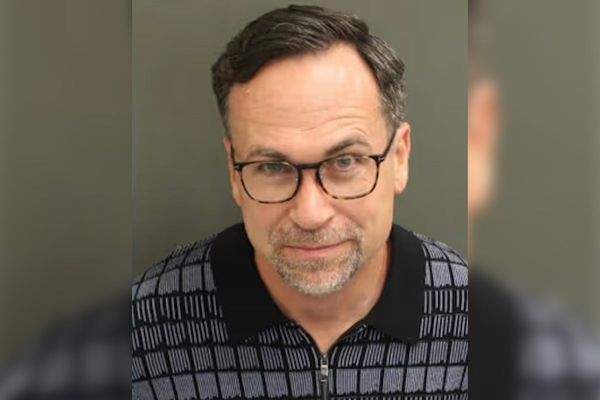"Really? surely not!" exclaims a lady as she's about to throw one of those toy bones to her Labrador while walking through a small "park" on the corner of Moynihan Street and Copland Drive in Evatt.
Her shocked response is consistent with that of other passers-by when I explain they're walking on the graves of some of Canberra's early pioneers.
The main reason so many people stroll through the St Paul's Burial Ground (sometimes referred to as Evatt Unmarked Cemtery) completely oblivious to its morbid past is that there is no obvious indication that it is a graveyard - all the grave markers have deteriorated or were vandalised before the suburb's construction in the early 1970s.

Sure, there are a couple of tiny plaques hidden amongst grass listing the names of those thought to be buried here and a more modern Canberra Tracks sign near the top entrance, but neither are near the well-worn diagonal track that dissects the historic site.
However, one man who knows just about every blade of grass at the so-called "ghost" graveyard is self-described "recreational historian" Rohan Goyne. The passionate history hound lives just around the corner and is using the upcoming Canberra & Regional Heritage Festival as a platform to shine the spotlight onto this inconspicuous suburban graveyard.
The graveyard was heritage listed in 2011 for several reasons, including that it's one of just three 19th-century churchyard burial plots in the ACT. The other two being St John's Canberra in Reid and Weetangera near Hawker.

So where, I hear you ask, is the pioneer church in this "park"?
Well, like all the headstones, that's long gone too.
"The church (St Paul's) was a long time coming for worshippers of the Ginninderra area," reveals Rohan. "Although land was granted to the church in 1841 by Charles Campbell, it wasn't until 1860 William Davis generously forked out 20 pounds for the construction of the small [5 metres wide by 9 metres long] bush church."
Documents still held by St Paul's Ginninderra (now based in Spence) describe the pioneer church, which opened on May 12, 1861, as made "partly of slab and weatherboard, partly of lath and plaster and crowned with a shingle roof. An entrance porch [2.5 metres square] and bell-loft added to the effect created by gothic windows constructed in timber."

Although you can't make out any chimney in early sketches of the church, apparently inside was also a "5-foot-square fireplace for warmth in winter." Cosy.
"Services were held here for about 40 years," explains Rohan. "Apparently at one stage the congregation was so big that some worshippers had to stand outside".
However, the establishment of nearby Hall village in 1882 and the subsequent loss of commercial power of Ginninderra sounded the death knell for the bush church which closed its doors permanently at the turn of the century.
After being badly damaged during a storm in 1904, it was then used as both a stable and then a shed to store farm equipment from the adjoining farm before collapsing in the 1920s.

"And now there's no trace left of it," explains Rohan.
However, the lack of in situ physical evidence won't stop Rohan informing those who flock to his one-off tour of the site on April 20 about tales of those laid to rest in the now unmarked graves.
"There are 18 known graves and potentially others, but the records are inadequate to resolve with any clarity who exactly was interred here," says Rohan. "It's believed the first known burial was of Ralph Edge in September 1872, while the last was that of two-year old Charlotte Eliza Stear who drowned in a well in September 1900.
"But there's a story behind each and every one buried here; tragedies like poor Thomas Holligan who was gored to death by a bull over at Ginninderra on October 25, 1887," he reveals. Four days after the deadly attack, the Queanbeyan Age reported on the 74-year-old's grisly end. "His body was fearfully lacerated and presented a cruel spectacle, the bull having ripped open the abdomen." Heck.

"While the parish faithful were buried close to the church, others were interred further down the hillside," explains Rohan. "It's also thought that at least two Aboriginal people who often gathered at nearby Ginninderra Creek are buried at the furthest corner from the church, under what is now Copland Drive."
Not content with sharing tales of this little-known graveyard, Rohan is calling on the ACT government to undertake further research of the site, consistent with its heritage listing.
"The real story here is under the ground and with modern techniques that are not invasive, authorities could map this area fairly effectively, and disturbances in the soil may mark a grave," he says.
Of course, the success of such a survey depends to what extent the land, especially the sub-surface, has been altered over the last century. And that may be problematic for as recently as 2006, a road gang set up a work compound on the former graveyard, unaware of its existence. They were only moved on after outraged nearby residents raised the alarm.
Armed with the knowledge of what lays just under the surface, let's hope on her next walk through the graveyard the lady with the Labrador keeps the toy bone firmly in her hand. At least until she's on the other side.
Rohan Goyne's tour - Stories from the Grave: St Paul's Evatt - is on Thursday April 20 at 10.30am. From $15pp. Bookings are essential. Ph 0483 231 458 or email rgoyne1@bigpond.com. For all 2023 Canberra & Region Heritage Festival events, see https://act.gov.au/heritagefestival
The stories buried deep in history
Wandering Reverend: Even into his 80s, The Reverend Pierce Galliard Smith, Rector (1855-1905) of St John's Canberra rode his horse around the district, including to St Paul's Ginninderra. According to church records "he used to give a Sunday morning service at St John's and an afternoon service at Ginninderra, visiting many people along the way". The good Reverend was also responsible for planting many of the trees in Glebe Park in Civic - apparently collecting the seeds during his travels around the district.
The Glebe: When, in 1841, Charles Campbell offered 200 acres on his Ginninderra property to the church, he stipulated that one acre was for the church building and two acres for a Church of England burial ground. The remaining 197 acres were to be used as a rural lease to support and maintain the church and grounds (known as a glebe). The Cameron family from Scotland, Donald and Ann and their children, were the lessees of The Glebe Farm from 1850 until the late 1880s and several family members are buried in the St Paul's Burial Ground.

Ongoing legacy: In 1916 The Glebe was purchased by the Australian government for 1139 pounds. Interest from this capital is now paid to the rector of St. Paul's Ginninderra. In the late 1960s The Glebe property, farmed by many decades by the Gribble family, was resumed and The Glebe farmhouse, located near current-day Copland College, was subsequently demolished to make way for the development of the suburb of Melba.
Dual purpose: Shortly after its opening in 1861, and until 1874, St Paul's doubled as the local school. It is believed that Hugh McPhee, who taught at St Paul's, is buried in one of those unmarked graves in the surrounding graveyard. But sadly, like all the graves, no one knows exactly where.
WHERE IN THE SNOWIES?

Rating: Medium - Hard
Clue: Hear the lion roar
How to enter: Email your guess along with your name and address to tym@iinet.net.au. The first correct email sent after 10am, Saturday April 1 wins a double pass to Dendy, the Home of Quality Cinema.

Last week: Congratulations to Leigh Palmer of Isaacs who was first to correctly identify last week's photo as Scrivener Dam under construction in 1962. Leigh just beat Scott Sieverts of Rivett and Chris Ryan of Kirrawee to the prize.
NO BULL

The mode of Thomas Holligan's untimely demise (see main story) wasn't a rare occurrence in 19th-century Australia. A search of historic newspaper articles reveals many instances of rampaging bulls goring farmers to death. It wasn't just farmers, but also early European explorers. Just last week while wandering the graveyard at Bong Bong Church (near Moss Vale) I stumbled upon the grave of convict-cum-explorer Joseph Wild, who is perhaps best-known as the first European to sight Weereewa (Lake George) in October 1820.

Three years later Wild accompanied Captain Currie and Major John Ovens on an expedition south of Bong Bong which resulted in the "discovery" of the Monaro Plains. Wild died on May 25, 1847, after being gored by a wild bull at Wingecarribee Swamp (just to the east of Moss Vale). What a way to go.
CONTACT TIM: Email: tym@iinet.net.au or Twitter: @TimYowie or write c/- The Canberra Times, GPO Box 606, Civic, ACT, 2601
We've made it a whole lot easier for you to have your say. Our new comment platform requires only one log-in to access articles and to join the discussion on The Canberra Times website. Find out how to register so you can enjoy civil, friendly and engaging discussions. See our moderation policy here.







